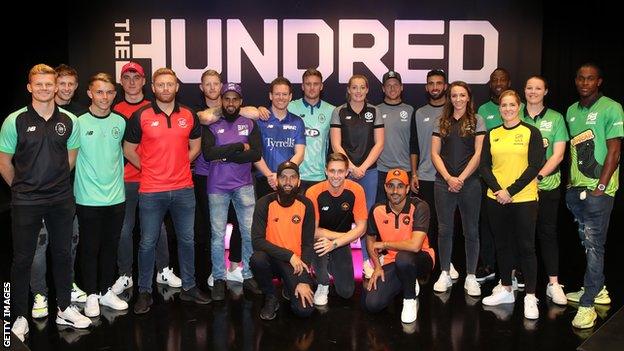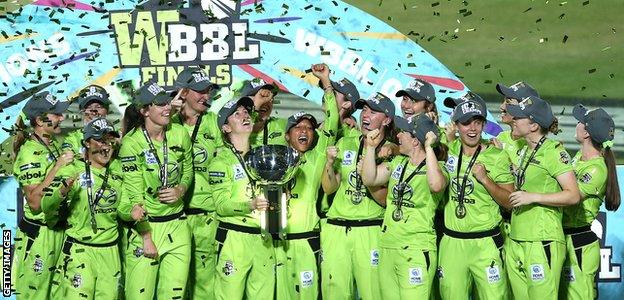The Hundred: Sophie Devine shows women's cricket can create heroes for boys and girls
- Published
Allow X content?
This article contains content provided by X. We ask for your permission before anything is loaded, as they may be using cookies and other technologies. You may want to read X’s cookie policy, external and privacy policy, external before accepting. To view this content choose ‘accept and continue’.
The first game of this summer's inaugural Hundred competition will be a women's match between Oval Invincibles and Manchester Originals. The match will be televised live on BBC television.
When a young cricket fan in New Zealand, Henry Darrow, was asked for his thoughts on the impressive innings of the male cricketer he had been watching from the crowd, he was full of praise, before observing that it was "not better than Sophie Devine, but still pretty good".
The analysis was simple: Finn Allen's knock, the one Henry had been watching, was a quickfire 75 off 33 balls.
Days before, Sophie Devine, the fourth ranked T20 women's batter in the world, had stormed to 108 off 38 balls in the corresponding women's domestic tournament.
What was remarkable about the comments of the young, male cricket fan was how Devine's innings had resonated. That Allen and Devine were different genders hadn't registered at all; Henry hadn't even hesitated.
A few years ago a similar story did the rounds:, external it showed the picture of a young black boy with his best friend, a young white boy, beaming at the camera while sporting similar crew cut hairstyles. They wanted to get the same haircut, one of the boys' mothers explained, to trick their teacher who, the boys reasoned, would therefore not be able to tell them apart.
Extend that to gender too; there is very little to suggest we're born with preconceived gender stereotypes. Like race, background, religion, these are things mostly learned, picked up from our environment, from what we watch and engage with.
And when it comes to sport, what we watch, listen to and read about remains overwhelmingly male. In the UK, the latest research suggests that across all different media platforms, women's sport only comprises between four and 10% of coverage.
This number, during the pandemic, is likely to have decreased, just as women's activity levels have found themselves disproportionately affected.
Which is why the Hundred, in some respects, could be transformational - beginning with the first game of the tournament.

From the very beginning, The Hundred has been marketed as a competition for both men and women
In the past few months, a young child switching on the television will have seen that men play Test cricket, men play in the IPL and men, in general, continue to play international cricket throughout the pandemic while women, largely, have not.
What Sophie Devine, and New Zealand, have shown is that if you give a reasonable share of that platform to women, cricket suddenly is for them too.
New Zealand lacks far behind England in many aspects of women's cricket. But it is increasingly apparent that both there and in Australia, the pedestal female cricketers are placed on is far closer to that of the men as compared to other countries, England included.
A smaller population and fewer competing sports may be contributing factors. However, when Australia played New Zealand in a rare women's bilateral series last year, it was notable how the respective countries' men's players and senior men's media watched them.
They tweeted about women's cricket, and wrote about them. Not because they felt obliged to, in a gender-equality drive, but because it was an opportunity to analyse, comment, and engage with a competitive series which was unfolding.
The Hundred, the first major franchise tournament to launch the men's and women's game simultaneously, is determined to change perceptions in England.
Beth Barrett-Wild, who is in charge of the women's Hundred competition for the England and Wales Cricket Board, believes this summer is the beginning of "a big opportunity".
"Normalising men and women playing cricket on the same team" is what, according to Barrett-Wild, is driving the ECB's strategy. "Marketing and investment really could be the thing that massively shifts the dial for the women's game."
The Big Bash League in Australia has demonstrated this; despite the men's BBL launching five years before the women's one, when the latter did arrive, it was incorporated directly into the branding, marketing and infrastructure of the popular men's tournament.
Now, as a standalone women's tournament, the WBBL is already starting to challenge the men's game for television viewership.
The men's and women's Hundred fixtures are set to be played as double headers this year which, Barrett-Wild says, is an opportunity for the women's game to share the stage, not just provide the warm-up act.
"Visibility is crucial," explains Barrett-Wild. "We're really presenting those two [men's and women's] matches to the same scale."

An audience of more than 400,000 watched the 2020 WBBL final in Australia
There is an argument this detracts from women's cricket succeeding as a standalone sport, as has proven possible already, both in the WBBL and when the Melbourne Cricket Ground was packed with almost 90,000 spectators for the T20 World Cup fnal last year.
The operational complexities presented by Covid surely contribute to the decision to stage double-headers but it is also driven by the tournament having been largely created for the broadcast market.
Hosting the men's and women's matches in the same large stadia, with the same inbuilt infrastructure, provides significantly increased opportunities for exposure on television, on radio and on social media - the platforms providing the widest reach.
The ECB appear to be starting as they mean to go on - the first Hundred game will be a woman's one - so it's clearly not just an afterthought.
More than half of the ECB team working on the Hundred are women and finally, it's starting to show.
"Everything we're doing is through a gender-balanced lens," adds Barrett-Wild. "How do we harness this opportunity so that it's not a surprise that the women are opening the competition and that it is just a completely normal thing to happen?"
To Henry Darrow in New Zealand, that normalisation has already started; now English cricket has an opportunity to do the same.